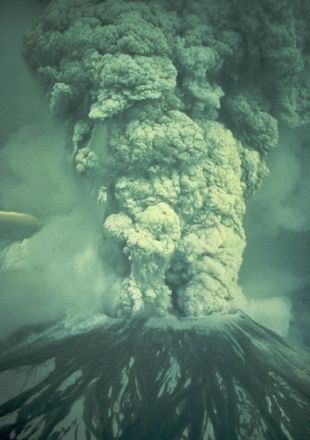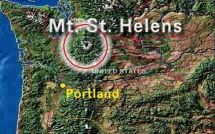
Publisher:
Bonnie King
CONTACT:
Newsroom@Salem-news.com
Advertising:
Adsales@Salem-news.com

~Truth~
~Justice~
~Peace~
TJP
Jan-10-2008 05:27

 TweetFollow @OregonNews
TweetFollow @OregonNews
RECALLING ERUPTION DAY When Mount St. Helens Roared
By John Eggink Special to Salem-News.comIt is one of many of these mountain peaks that periodically show evidence of explosive violence.
 Mt. St. Helens Photo courtesy: USGS |
(SALEM Ore.) - The Date: May 18, 1980
It does not seem possible that this natural disaster occurred over twenty-seven years ago. At the time I was well into my teaching career, having taught twenty-four years; all but two years of this time was spent in the classroom of Oakridge High School nestled in the western Cascades Mountain Range of Oregon.
In 1958 I had a mild interest in geology, having taught a unit on minerals and rocks in a class called General Science. After being evaluated by my Assistant Principal, he was so impressed by my teaching, he suggested strongly that I develop a class emphasizing the science of geology. As a result of this, Earth Science-Geology became one of the most popular selections in the science department.
As the years rolled by, it was my good fortune to be selected by the National Science Foundation to study Earth Science at Kansas State University and the University of Vermont, during two summer sessions. This experience helped me to be more qualified to teach geomorphology--the science that explores aggradation and degradation, forces that have built up and torn down the crust of the earth.
It was a blessing to have taught in the Western Cascades, an area that has had a very interesting volcanic past. An important part of our studies in geology at Oakridge H.S. was centered upon vulcanism, which was responsible for the formation of the Cascade Range. Students in my geology classes became well aware of the dominant mountain peaks, Dead Mtn., Diamond Peak, Willamette Pass and those mountains in the younger High Cascades to the east, Mt. Hood, the Three Sisters and Bachelor Butte.
The Cascade Range extends northward into the state of Washington with dominant peaks, Mt. Baker, Mt. Rainier and of course the eruptive Mount St. Helens.
Perhaps for over a decade, I cautioned my geology students to consider the vitality of these above-mentioned mountains. Perhaps they were extinct, dormant or active volcanoes and my emphasis based on empirical evidence was that several of them could be considered to be dormant. Think of them as "sleeping giants" that could re-awaken with explosive violence. Long before the eruption of St. Helens, peaks like Mt. Hood and Rainier showed evidence of deep crustal forces at work within their layered structures. Most all of the mountains in the High Cascades are strato volcanoes or composite cones, very well named for they are composed of alternating layers of ash and lava. The "ash" is composed of pyroclastics, or fire-fragmented particles.
The eruption of St. Helens was a very dramatic event in my life, for it occurred on my 49th birthday. My two sons, Mark and Steven were visiting me and my family, helping to celebrate this happy day. I recall vividly being outside with my two sons, when my wife called to us, "Come into the house and watch Mount St. Helens erupting." And so we did, and what an awesome sight to behold! As a teenager I had hiked on the flanks of this majestic peak and now in 1980 it was difficult to realize that a major portion of the summit was no more.

The consequences of this event were many:
1) the logging of Weyerhaeuser Timber Co. was shut down,
2) thousands of acres of valuable forest was destroyed,
3) lovely homes in the Toutle River Valley were destroyed,
4) the Toutle River of Washington flows into the Columbia River -- choked with pyroclastics, it clogged shipping channels of the mighty river of the West, dramatically affecting the economy of the Pacific Northwest,
5) motorists experienced carburetor problems with their vehicles; the air was heavily polluted with fine-grained ash.
Portland, Oregon, less than 100 miles from the blast, reported many auto failures due to poor air quality. Even communities as far away as Montana reported visibility problems that obstructed driving.
In retrospect, my students often regarded me as a prophet, in forecasting an imminent explosion of one of the major Cascade volcanic peaks. Though I have been out of the classroom for fourteen years, the possibility of still another volcanic eruption looms as quite possible, for many of these mountain peaks periodically show evidence of explosive violence.
--John Eggink
Articles for January 9, 2008 | Articles for January 10, 2008 | Articles for January 11, 2008

Salem-News.com:



googlec507860f6901db00.html
Terms of Service | Privacy Policy
All comments and messages are approved by people and self promotional links or unacceptable comments are denied.
bob January 25, 2008 10:26 am (Pacific time)
that is pretty cool
[Return to Top]©2025 Salem-News.com. All opinions expressed in this article are those of the author and do not necessarily reflect those of Salem-News.com.